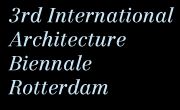| PowerNotes #06 Strategies for a Better World | |
In connection with the theme of the Biennale, the Netherlands Architecture Institute (NAI), in the exhibition ‘A Better World - Another Power', is presenting a number of fresh initiatives by groups that use a bottom-up approach within urban design. A conversation about this with Ole Bouman (director of the NAi since 1 April 2007): | |
|
Rotterdam - Friday 1 June
In contrast to the great forces and powers being presented in the Kunsthal, the exhibition at the NAI seems to be based on ‘Power to the People' . . . ‘A Better World - Another Power' is an exhibition by curator Emiliano Gandolfi. I think he has chosen a very good approach, in that he manages to draw attention to a number of artistic and simultaneously socially motivated initiatives that demonstrate that one does not necessarily have to think in terms of blueprints. Through various initiatives from the art and design world, Gandolfi shows that design can also be about a kind of ‘enabling' capacity: a capacity to make things possible by making connections from which a new (urban) energy emerges, which can ultimately lead to a sense of community or a stronger identity for a neighbourhood, or to better communication. These are designers of dialogue and of urban-design organization, far more than designers of form. Dialogue is increasingly important, and the designers on display are more or less pioneers of this new practice.
Designers are becoming process managers? We just heard during the lecture given by Peter Bishop (Design for London) about the plans for London over the next 20 years. He too said that with only an intelligent design you're nowhere. What is most important is the process through which you make things possible. Process design is a fully-fledged component of the palette with which designers can manifest themselves. This may not lead immediately to formal recognizability (the signature of the designer) but it does lead to results.
During the first week of the Biennale, two discussion evenings were held as part of 'A Better World - Another Power': ‘Open!' and ‘Activism!' - what came out of these? Each was a kind of brainstorming session. The evening began with a few informal round-table conversations with the audience. In small groups, we discussed several aspects inherent to the practices we've mentioned. Then we discussed how an architecture institute can serve as a podium to focus attention on this design that cannot be immediately reduced to a form. That was very useful!
|
Can we expect more of this sort of inspirational, interactive conversations in the future? We as the NAI are definitely going to organize regular events to which you bring new ideas. But of course something has to be done with such proposals.
What does the NAI hope to achieve with ‘A Better World'? I think it would be great if this approach found more widespread support and if more people looked into it. At the moment these are still only incidental instances, where one individual tries to initiate something on a local level. There is no systematic approach yet - for that, greater persuasive power is needed, and that's what we're trying to mobilize with this exhibition and these discussions.
|
POWER -
Producing the Contemporary City
24 May - 2 September 2007
Producing the Contemporary City
24 May - 2 September 2007
Nederlands | English
"In the USA alone, well over 3 million acres of open land are lost each year to suburbanisation" (Kenneth Frampton in Producing The Contemporary City, 2007)


